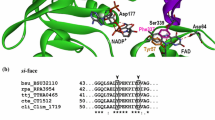Abstract.
The redox properties of the blue copper protein amicyanin have been studied with slow and fast scan protein-film cyclic voltammetry. At slow scan rates, which reveal the thermodynamics of the redox reactions, the reduction potential of amicyanin depends on pH in a sigmoidal manner, and the data can be analysed in terms of electron transfer being coupled to a single protonatable group with pKa red=6.3 and pKa ox≤3.2 at 22 °C. Voltammetry at higher scan rates reveals the kinetics and shows that the low-pH reduced form of amicyanin is not oxidised directly; instead, oxidation occurs only after conversion to the high-pH form. Simulations show that this conversion, which gates the electron transfer, occurs with a rate constant >750 s–1 at 25 °C. In order to decrease the rate of the coupled reaction, the experiments were performed at 0 °C, at which the rate constant for this conversion was determined to be 35±20 s–1. Together with evidence from NMR, the results lead to a mechanism involving protonation and dissociation of the copper coordinating histidine-96 in the reduced form.
Similar content being viewed by others
Author information
Authors and Affiliations
Additional information
Electronic Publication
Rights and permissions
About this article
Cite this article
Jeuken, L.J., Camba, R., Armstrong, F.A. et al. The pH-dependent redox inactivation of amicyanin from Paracoccus versutus as studied by rapid protein-film voltammetry. J Biol Inorg Chem 7, 94–100 (2002). https://doi.org/10.1007/s007750100269
Received:
Accepted:
Published:
Issue Date:
DOI: https://doi.org/10.1007/s007750100269




